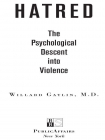Hatred, Willard Gaylin [best ebook for manga txt] 📗

- Author: Willard Gaylin
Book online «Hatred, Willard Gaylin [best ebook for manga txt] 📗». Author Willard Gaylin
Lower animals, with no conscience mechanisms, do not require such emotions as guilt and shame. Guilt and shame are designed to serve our moral values, our better selves. Lower animals do not have “better selves.” They are what they are for good and bad, fixed by nature. Fear and rage, however, are emotions common to both the beasts and to us, and we understand their mechanisms better because of the capacity to do animal studies. But the trigger in human beings for either of these emotions differs vastly from that in other animals.
It is impossible to analyze anger without considering it in conjunction with fear. Fear and anger are usually so inextricably intertwined that a psychotherapist is likely to ask a frightened patient what he is angry about, and to ask an angry patient what is frightening him. Fear and rage are generally perceived as the two basic emotions that support our behavior in emergencies. They are part of an elaborate emergency response mechanism built into higher animals. Rage sets in motion the machinery for a frontal physical assault: Appropriate skeletal muscles are tensed; certain muscles are contracted and opposing ones are relaxed; the autonomic system moves to increase the supply of adrenaline and redistribute the blood flow of the body. All of this to prepare the body as an assault weapon.
With fear, the same kinds of physiological responses are initiated, but with opposite distributions of neural stimulation and body chemicals, wiring, and the preparation of different muscles. This time, to facilitate escape. These reactions, wonderfully researched over the years, have come to be called “the fight or flight” responses, after the pioneering work of the American physiologist Walter B. Cannon almost one hundred years ago.17 A typical animal experiences these two emotions—and probably only these two—on those occasions when it, its territory, or its breeding rights are under attack. The zebra feels terror with the scent of the lion. He feels rage when the younger male zebra intrudes on his horde.
Most of an animal’s time is spent free of emotions. Its “work” is survival, and in that it is guided by rigid instinctual patterns built into its physiology. Food, sex, care of the young, and defense of territory are its sole concerns. Hyenas are not stimulated by imagination of a better life that might be, nor haunted by a sense of inadequacy and deficiency for failing to be better parents or citizens of the community than they are.
Animals survive with the limited resources offered by their biological makeup. They live the same way in the same places doing the same things that their ancestors did eons before. The lamprey inhabits the same ocean depths and is occupied with the same activities that its ancestors did back to the first lamprey of its species. Animals do not imagine the unimaginable. The lion does not aspire to fly like an eagle, roam the seas like a whale, or build “mansions” like termites. Uninspired by imagination, animals do not build ships to explore new worlds, seek new wealth to build new palaces, erect new cities of a grandeur and style inconceivable to their ancestors in the caves. Only Homo sapiens does these things. Only human beings have higher goals and purposes and are equipped with the broad range of feelings that serve this creative imagination. Still, in an emergency, when faced with danger, we will respond with the same basic emotions and physiological responses as the bear and the bobcat.
These emergency emotions of fear and rage were established—biologically fixed through adaptation—into our physiology in those barbaric times that preceded civilized life. For prehistoric people, the meaning and nature of danger were unequivocal. A threat to survival was present. The danger was real and physical—a predatory beast, an enemy horde, a rebellious member of the clan. In these conditions, these emergency emotions served us well. We became an armed instrument for assault. But how about today?
In civilized society—even before the actual threats of terrorists made our culture seem devoid of civilized restraints—we continue to respond to perceived threats with fear and rage. We gear ourselves up for assault. But assault on what? In our civilized existence what dangers remain that are satisfactorily resolved by clubbing? Often it is not the enemy we face, but his agent; more often than not, we are confronted by an idea, a doctrine, or a document—an eviction notice, a dismissal slip, a divorce decree. How does one attack such threats? With one’s teeth? We all constantly arm ourselves for dangers that are not physical and cannot be handled via either fight or flight. Worse, some of the threats we perceive exist only in our imaginations.
Once we convince ourselves that the danger is real, we may behave in such a way as to create the very things we contemplate with dread. In either case, the biology set for a prehistoric way of life does not serve us well in the civilized world we now inhabit. What served the human species so well for the million and a half or more years that we lived in caves has been undone by a mere ten thousand years or so of civilization.
Actual violence still does occur in everyday life, even for twenty-first-century human beings. There is the urban violence of the mugger and his victim; there is the violence in the family where a brutal or drunken man may exercise his rage and frustration on his wife and children, inflicting life-threatening injuries on the helpless. Warlike intertribal battles still occur in some areas. We see it in Africa, where traditional tribes and nations may be confined within





Comments (0)